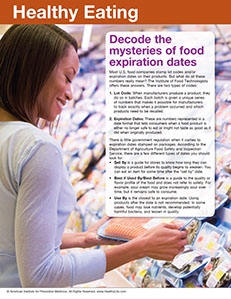SYMPTOM CHECKER
CONDITIONS
Male
Female
Child
Arm, Hand & Shoulder Concerns
Legs & Feet Concerns
Dental & Mouth Concerns
Ear & Nose
Eye Conditions
Head Conditions
Arm, Hand & Shoulder Concerns
Legs & Feet Concerns
Front
Back
Arm, Hand & Shoulder Concerns
Dental & Mouth Concerns
Ear & Nose
Eye Conditions
Head Conditions
Arm, Hand & Shoulder Concerns
Dental & Mouth Concerns
Ear & Nose
Eye Conditions
Head Conditions
Front
Back
Arm, Hand & Shoulder Concerns
Neck Links
Head & Neck Concerns
Arm, Hand & Shoulder Concerns
Neck Links
Head & Neck Concerns
Front
Back
Online Clinic
Wise Healthcare
Decode the mysteries of food expiration dates
Print on Demand
Most U.S. food companies stamp lot codes and/or expiration dates on their products. But what do all these numbers really mean? The Institute of Food Technologists offers these answers. There are two types of codes:
1. Lot Code: When manufacturers produce a product, they do so in batches. Each batch is given a unique series of numbers that makes it possible for manufacturers to track exactly when a problem occurred and which products need to be recalled.
2. Expiration Dates: These are numbers represented in a date format that tells consumers when a food product is either no longer safe to eat or might not taste as good as it did when originally produced.
There is little government regulation when it comes to expiration dates stamped on packages. According to the Department of Agriculture Food Safety and Inspection Service, there are a few different types of dates you should look for:
• Sell By is a guide for stores to know how long they can display a product before its quality begins to weaken. You can eat an item for some time after the “sell by” date.
• Best if Used By/Best Before is a guide to the quality or flavor profile of the food and does not refer to safety. For example, sour cream may grow increasingly sour over time, but it remains safe to consume.
• Use By is the closest to an expiration date. Using products after the date is not recommended. In some cases, food may lose nutrients, develop potentially harmful bacteria, and lessen in quality.
This website is not meant to substitute for expert medical advice or treatment. Follow your doctor’s or health care provider’s advice if it differs from what is given in this guide.
The American Institute for Preventive Medicine (AIPM) is not responsible for the availability or content of external sites, nor does AIPM endorse them. Also, it is the responsibility of the user to examine the copyright and licensing restrictions of external pages and to secure all necessary permission.
The content on this website is proprietary. You may not modify, copy, reproduce, republish, upload, post, transmit, or distribute, in any manner, the material on the website without the written permission of AIPM.
2021 © American Institute for Preventive Medicine - All Rights Reserved. Disclaimer | www.HealthyLife.com
















































